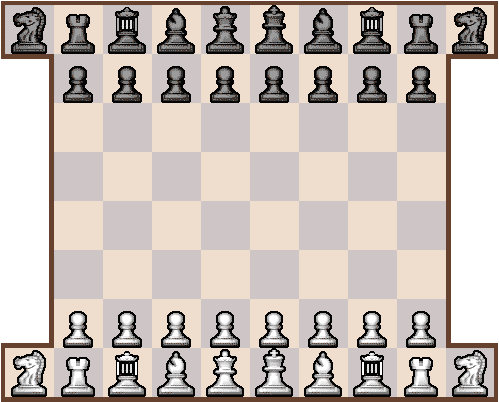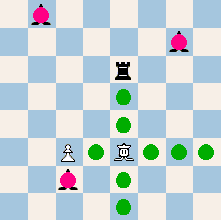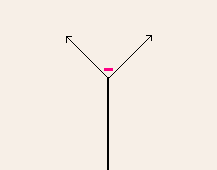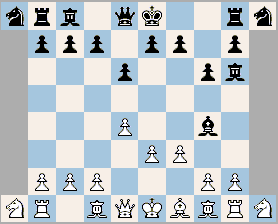

The Secutor is a bifurcation piece. It slides on the orthogonals like a rook. It captures by colliding against any piece and then deviating to any of the two adjacent diagonals (in the prolonged movement direction). Thus to capture, the Secutor jumps directly to an enemy piece and lands on it, provided that any intermediate squares are empty. The Secutor's value is 3, that is, the same as bishop or knight (estimate).
Other rules are the same as in standard chess, except for the possible promotion to Secutor, and the extended castle. When castling the king may jump three squares, but it can also jump two as usual. The rook ends up on its usual square. The extended castle rule makes play on the wings easier to achieve. The king can rapidly take control over the corner square.
As it can capture by coordinating with another piece, the Secutor is a highly cooperative piece, something which makes it interesting for the positional player. The structure on the board decides its possibilities. The Secutor loses less power in the endgame than one would expect. Although screens for colliding become fewer, its scope and mobility also increases. Note! If positioned on the second or seventh rank, the Secutor can collide with the rim in order to capture a piece on any of the extra corner squares. Secutor Chess, and the new Secutor piece, were invented by undersigned, September 2006.
The secutor ("pursuer") was, together with the retiarius ("net man"), the best-known type of gladiator in ancient Rome. The secutor wore a rounded helmet with two round eye holes, a short sword (gladius), an arm guard (manica), leg guards (ocrea), and a large oval shield.
 The Secutor can move in two legs, the first is a rook slide and the second is a diagonal collision-capture, which is optional (red = capture).
The Secutor can move in two legs, the first is a rook slide and the second is a diagonal collision-capture, which is optional (red = capture).
 The Secutor's capture principle. The screens, that are used for colliding, occur anywhere on the first leg.
The Secutor's capture principle. The screens, that are used for colliding, occur anywhere on the first leg.
 This is a simple example of bifurcation tactics in Secutor Chess. Black has played Bg4 and threatened the white queen, while the bishop is guarded by the black Secutor at b8. White has played f3, and now black can play Bh3! check. The Secutor on h6 checks the white king because the black bishop placed himself as a collision screen. It's this type of tactics that always occurs with bifurcation pieces, and it's a different kind of tactics than with other pieces.
This is a simple example of bifurcation tactics in Secutor Chess. Black has played Bg4 and threatened the white queen, while the bishop is guarded by the black Secutor at b8. White has played f3, and now black can play Bh3! check. The Secutor on h6 checks the white king because the black bishop placed himself as a collision screen. It's this type of tactics that always occurs with bifurcation pieces, and it's a different kind of tactics than with other pieces.
• You can download my free Secutor Chess program here (updated 2009-06-17), but you must own the software Zillions of Games to be able to run it (I recommend the download version).
• You can play Secutor Chess online, or per email, here.
• Don't miss my other chess variants.
© M. Winther (September 2006).